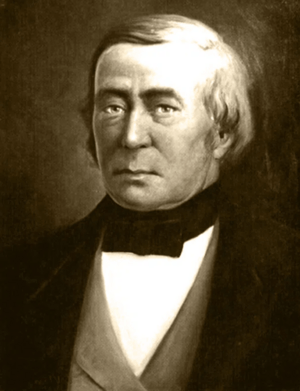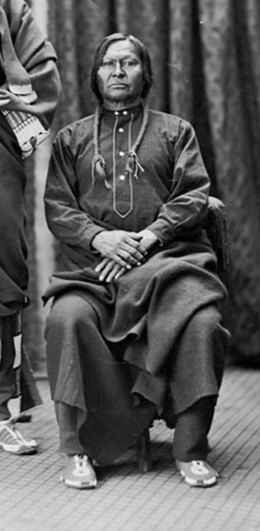Thomas Fitzpatrick (trapper) facts for kids
Quick facts for kids
Thomas Fitzpatrick
|
|
|---|---|
 |
|
| Born | c. 1799 |
| Died | February 7, 1854 (aged ~55) Washington, D.C., United States
|
| Resting place | Congressional Cemetery, Washington, D.C. |
| Nationality | Irish-American |
| Other names | "Broken Hand" |
| Occupation | Mountain Man, trapper, guide, Indian agent |
| Spouse(s) | Margaret Poisal |
| Children | Friday, Arapaho Chief (unofficially adopted) |
| Relatives | Chief Niwot (wife's maternal uncle) |
Thomas Fitzpatrick (born around 1799 – died February 7, 1854) was an amazing Irish-American adventurer. He was a fur trader, a "mountain man," and an agent who worked with Native American tribes. He explored much of the American West.
Fitzpatrick helped discover important routes through the Rocky Mountains, like the South Pass in Wyoming. This pass became a key pathway for pioneers heading west. He also guided many groups, including the first wagon trains to Oregon.
He was known as "Broken Hand" because of an injury to his left hand. Thomas Fitzpatrick also formed a special friendship with an Arapaho boy named Friday. Friday later became an important leader and peacemaker for his people. Fitzpatrick worked hard to create peace and understanding between different groups. He helped negotiate important agreements, like the Fort Laramie Treaty of 1851.
Contents
Thomas Fitzpatrick's Early Life
Thomas Fitzpatrick was born in County Cavan, Ireland, around 1799. His family was comfortable, and he received a good education. When he was younger than 17, he left home to become a sailor.
He eventually arrived in New Orleans, a big city in America. From there, he traveled north along the Mississippi River. By the winter of 1822–1823, he reached St. Louis, Missouri. This city was a busy hub for explorers and traders heading west.
Becoming a Mountain Man and Trapper
In 1822, two fur traders, Andrew Henry and William Henry Ashley, put out an advertisement. They were looking for brave young men to join their Rocky Mountain Fur Company. Thomas Fitzpatrick answered the call.
He joined other famous mountain men like Jim Bridger and Jedediah Smith. These men were skilled at trapping animals, especially beavers, for their valuable fur. This fur was used to make hats and other clothing.
In 1823, Fitzpatrick faced a challenge when a Native American tribe, the Arikara, blocked their usual river route. To find a new way, Fitzpatrick and Jedediah Smith led a small group overland. They were looking for a path through the towering Rocky Mountains.
In 1824, they rediscovered South Pass in Wyoming. This wide, gentle pass became a crucial route for pioneers traveling west. It was a much easier way to cross the mountains.
Fitzpatrick became very successful in the fur trade. He led groups of trappers and organized "rendezvous" gatherings. These were big events where trappers could trade their furs for supplies and enjoy some fun on the frontier. By 1830, he became a senior partner in the Rocky Mountain Fur Company.
He had many adventures, including being chased by a group of Gros Ventre people in 1832. This intense experience was said to have turned his hair gray early! Later, he helped lead a group of trappers and allied Native Americans in a conflict known as the Battle of Pierre's Hole.
The Rocky Mountain Fur Company eventually closed in 1834. Fitzpatrick continued his work, becoming a leader for the American Fur Company.
A Special Friendship: Thomas and Friday

In 1831, Thomas Fitzpatrick made a remarkable discovery. He found a young Arapaho boy who had become separated from his family. The boy was alone near the Cimarron River in what is now Colorado.
Fitzpatrick found the boy on a Friday, so he named him Friday. He took the boy under his care and sent him to a school in St. Louis, Missouri, for two years. Friday learned a lot there.
After school, Friday often joined Fitzpatrick on his trapping trips in the West. In 1838, they met a group of Arapaho people. A woman recognized Friday as her son, and he happily returned to his family. Friday and Fitzpatrick remained close friends for the rest of Fitzpatrick's life. Friday grew up to be a respected leader, interpreter, and peacemaker among the Arapaho people.
Guiding Explorers and Pioneers
As the fur trade changed, Fitzpatrick found a new important role: a guide. He became famous for leading groups safely through the vast American West.
He guided some of the very first wagon trains of pioneers heading to Oregon. These included the Whitman-Spalding Party in 1836 and the Bartleson-Bidwell Party in 1841. He helped these early settlers find their way to new homes.
Fitzpatrick also served as the official guide for famous explorer John C. Frémont on his expeditions between 1843 and 1845. He helped map and understand the western lands. In 1845, he guided Colonel Stephen W. Kearny and his soldiers on westward trails. He also traveled with Kearny's men in 1846 during a time of conflict with Mexico.
Working for Peace: Indian Agent
In 1846, Thomas Fitzpatrick took on another vital role: an Indian Agent. He worked in the Upper Platte and Arkansas River Valleys, which is a large part of what is now Colorado. He was respected by both Native American tribes and white settlers.
His job was to help keep peace and understanding between these different groups. He worked with tribes like the Arapaho, Cheyenne, and Lakota Sioux.
Fitzpatrick was a key negotiator for the important Fort Laramie Treaty of 1851. This was a huge meeting, bringing together many Native American leaders from the Plains. He also helped negotiate the Treaty of Fort Atkinson in 1853 with the Plains Apache, Kiowa, and Comanche tribes.
Family Life and Important Partnerships
In November 1849, Thomas Fitzpatrick married Margaret Poisal. Margaret's father was a French-Canadian trapper, and her mother was an Arapaho woman named Snake Woman. Margaret was also the niece of Arapaho Chief Land Hand, also known as Chief Niwot.
Thomas and Margaret had a son, Andrew Jackson Fitzpatrick, born in 1850. Their daughter, Virginia Tomasine Fitzpatrick, was born in 1854, after her father had passed away.
Margaret Poisal was a very important person in her own right. She was a skilled translator for the Arapaho people. She often worked with Fitzpatrick at important meetings, helping everyone understand each other. After Fitzpatrick's death, she continued this vital work, serving as an official interpreter for the Arapaho.
His Last Journey and Lasting Impact
In the winter of 1853–1854, Thomas Fitzpatrick traveled to Washington, D.C.. He was there to help finalize the Treaty of Fort Atkinson. Sadly, while in Washington, he became ill with pneumonia and passed away on February 7, 1854. He was buried in the Congressional Cemetery in Washington, D.C.
Thomas Fitzpatrick left a lasting mark on American history. He was a brave explorer, a skilled guide, and a dedicated peacemaker.
His contributions are still remembered today. In 2004, he was honored by being inducted into the Hall of Great Westerners. This is part of the National Cowboy & Western Heritage Museum. A mountain peak in Colorado, Broken Hand Peak, was also named in his honor in 1970.
See also
 In Spanish: Thomas Fitzpatrick para niños
In Spanish: Thomas Fitzpatrick para niños


